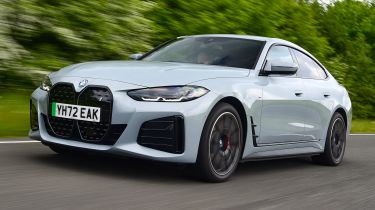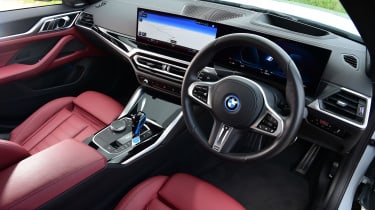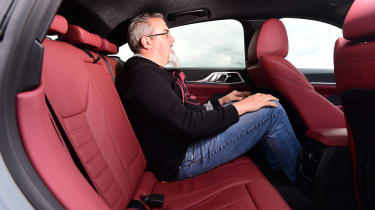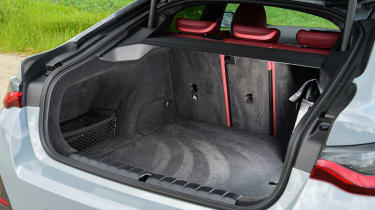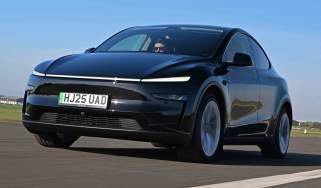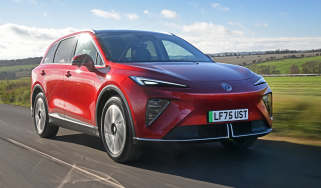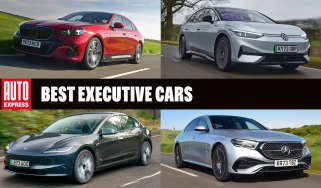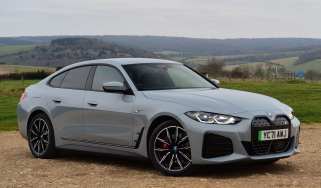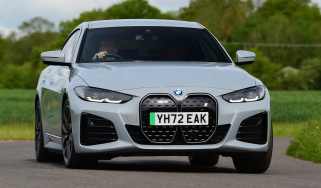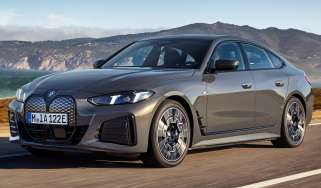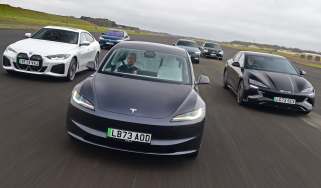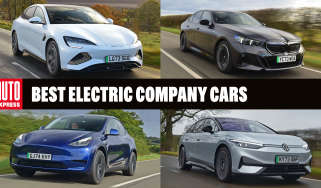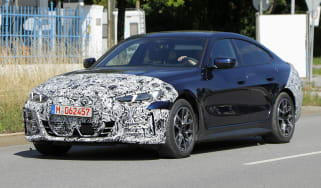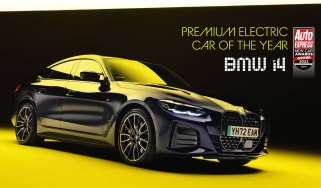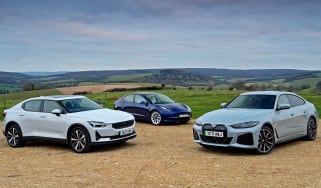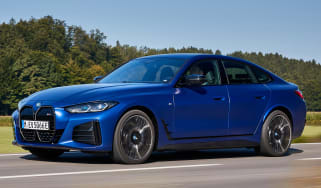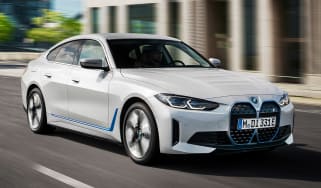BMW i4 review
Sophisticated, well-built and typically great to drive, the all-electric BMW i4 is an easy car to recommend

Quick review
The engineers in Munich have done a fine job with the BMW i4. It’s the fully electric version of the 4 Series Gran Coupe, and the move to battery power has simply highlighted the German manufacturer’s renowned engineering skill. Buyers can rest assured that none of the company’s driver-focused DNA has been lost in translation.
But, it’s not just keen drivers who will be impressed with the i4, because the Gran Coupe oozes quality and is packed with the latest on-board technology, while a decent range and useful rapid charging ability add to its appeal as a superb all-rounder. Yes, the i4 costs a touch more than its close rivals, but we think it’s worth every penny, which is why it’s won our Premium Electric Car of the Year award two years on the trot in 2022 and 2023.
About the BMW i4
BMW has a rich heritage of producing cars that are fantastic to drive. Whether it’s an executive saloon or a quirky supermini, a large SUV or a two-seater roadster, the Bavarian automaker rarely misses when it comes to delivering a car that just makes you want to get behind the wheel and hit the road. It’s a trait not only shared by its combustion-engined cars, but its EVs too.
Used - available now
BMW’s electric car line-up has expanded faster than many other brands, with its range of models under the ‘i’ sub-brand including the BMW iX1 and BMW iX3 family SUVs, the larger, more luxurious BMW iX SUV and the BMW i7 luxury limousine (the latter being our 2023 Luxury Car of the Year, no less). There’s also a zero-emissions version of the eighth-generation BMW 5 Series called the BMW i5, which will be available in saloon and practical Touring estate forms.
Of course, BMW is known to many for its more compact executive saloon, the hugely popular BMW 3 Series. We’re yet to see an electric 3 Series, but the i4 is a more than capable substitute. It’ll be instantly familiar to many BMW owners because it’s essentially a battery-powered BMW 4 Series Gran Coupe, so you get five doors, including a handy hatchback tailgate.
Saloons might not be as popular as SUVs these days, but the i4 still has its EV saloon foes. The recently facelifted Tesla Model 3 is the standard bearer for compact electric saloons, while the Polestar 2 adds a whiff of coupe-SUV styling to the mix, and is capable of covering over 400 miles on a single charge in the right configuration. The dramatic, swooping Hyundai Ioniq 6 is another appealing option, with its spacious interior and long kit list helping to sweeten the deal, while the Volkswagen ID.7 offers comfort and practicality in equal measure.
There are three versions of the i4 available to order. The least expensive option is the eDrive35, which uses a 70.2kWh battery (67kWh useable), a 282bhp electric motor to drive the rear wheels, and provides 311 miles of range. The eDrive40 gets a larger 83.9kWh battery (80.7kWh useable) and 335bhp motor, bumping the maximum range up to 373 miles in Sport trim. Both models are also offered in the more desirable M Sport trim, which adds different rims, adaptive suspension and some styling tweaks for a sportier look, but also reduces the car’s range slightly.
Meanwhile, the 536bhp i4 M50 was BMW’s first electric car to receive input from the manufacturer’s M Division motorsport arm. Air suspension is standard on all models, and the M50’s all-wheel drive setup and adaptive M dampers provide keener drivers with greater stability on the limit of grip. Its extra power and an additional electric motor driving the front wheels cut the range down to 315 miles.
Electric motor, drive and performance
The BMW i4 features the brand’s fifth-generation of eDrive electric motors, with the motor itself, transmission and electronics all contained in a single unit for greater efficiency. But, arguably, the manufacturer’s greatest achievement with the i4 is the way it drives. Despite weighing in at over two tonnes, the five-door Gran Coupe is superb through the corners with plenty of grip, a precise feel to the steering and no hint of understeer. Aside from the lack of combustion noise, we think you’d struggle to tell the difference between the i4 and a fossil-fuelled BMW 4 Series Gran Coupe out on the road.
Considering how heavy the i4 is, you might think it would deliver a firmer ride, but if you go for an M Sport model and specify the M Sport Pro pack, you’ll get adaptive suspension where you can customise the car’s ride. In Comfort mode, the dampers soak up most imperfections in the road and help keep things relaxed – whether on a twisty B-road or longer motorway journeys, making the i4 a great long-distance cruiser.
BMW has been particularly clever with the position of the i4’s battery; it sits low in the car’s floor and gives a centre of gravity that is 53mm lower than a BMW 3 Series saloon – going someway to offsetting the extra weight of the electric i4.
The i4's refinement is excellent. This electric BMW was the quietest car in our company car group test, even against the improved Tesla Model 3, which has had a lot of work done to dampen down unwanted noise.
0-62mph acceleration and top speed
The rear-wheel drive, single motor i4 eDrive35 produces 282bhp, which enables it to sprint from 0 to 62mph in six seconds exactly, while the eDrive40 pumps out a more generous 335bhp, shortening the same sprint to a brisk 5.7 seconds. The top speed for both models is 118mph.
The quickest i4 is the four-wheel drive, twin-motor M50. Normally, it produces 469bhp, but this can be increased to 537bhp for 10-seconds in ‘Boost’ mode, allowing you to get from 0-62mph in a rapid 3.9 seconds. The M50 also has the highest top speed of 139mph.
No version of the BMW i4 feels particularly slow, with the base i4 eDrive35 getting a healthy 400Nm of torque, so it still seems very quick off the line. The extra power and torque (430Nm) of our preferred eDrive40 does a great job of contracting the additional weight of its larger capacity battery pack. Meanwhile, the M50 feels suitably rapid, but is likely to play second-fiddle to the updated Tesla Model 3 Performance, which is quoted to have a sub 3.0 second acceleration time.
Range, charging and running costs
Every version of the BMW i4 officially manages to hit the 300 miles of electric range sweet spot; the updated eDrive35 gets 311 miles, the eDrive40 gets 373 miles, while the four-wheel drive M50 gets 324 miles. That’s more than enough range for daily driving, and allows you to tackle the odd longer trip without having to keep leapfrogging between rapid chargers.
The efficiency of the i4 helps contribute towards such a long range. During our company car group test, a pre-facelift version of the eDrive35 managed 3.6 miles per kWh, putting it behind the 3.8 miles per kWh a Tesla Model 3 Long Range got, but ahead of the 3.3 miles per kWh of the Polestar 2 Single Motor Long Range, and 3.1 miles per kWh of the Hyundai Ioniq 6.
The eDrive35 uses a 70.2kWh battery (67kWh useable), while the eDrive40 and M50 both use an 83.9kWh (80.2kWh useable) battery for greater range. All models get a standard heat pump, which provides a more efficient way of heating the interior in cold weather without compromising the electric range too much, so you should still be able to go quite far, even in colder climates. Just be warned that the extra weight and four-wheel drive system of the M50 reduces the range dramatically, as do some of the larger wheel options.
The i4’s maximum charging speed depends on which model you get: the base eDrive35 maxes out at 180kW, while the eDrive40 and M50 can hit 207kW if you use an ultra-rapid charger capable of those speeds. Regardless, a 10 to 80 per cent charging session will take just over half an hour for all versions. Buyers receive a free 12-month subscription to the Ionity Plus and BP Pulse charging network, which helps manage running costs, particularly if you cover bigger mileages and frequently use rapid chargers. Afterwards, you can get a BMW Charging card, which offers customers fixed price AC (slow charging) and DC (rapid charging) per kWh.
If you have the space to install a typical 7.4kW home wallbox charger, the eDrive35 will take around 11 hours to charge fully, while the eDrive40 and M50 will take 13 hours.
Insurance groups
With insurance premiums for electric cars often being higher than those of combustion-engined cars, BMW has achieved a competitive insurance group rating for the i4. On the 1-50 scale, the i4 eDrive40 sits in group 35 if you opt for Sport trim, or group 36 for M Sport version. Surprisingly, the cheaper i4 eDrive35 lands in group 38 in both Sport and M Sport specifications. Meanwhile, the M50 falls in group 43.
That’s on par with the updated Tesla Model 3 in groups 36-41, but the Polestar 2 attracts much higher insurance ratings, starting in group 40, before finishing in group 45.
Check any car's MoT history in a few easy clicks with our MoT checker tool...
Depreciation
According to our latest data, the i4 will hold onto between 50 and 55 per cent of its original list price after three years and 36,000 miles of motoring. In case you’re wondering, the M50 is projected to retain the least value, while the entry-level eDrive35 leads the pack.
In comparison, the Tesla Model 3 and Polestar 2 are expected to retain 52 to 56 and 41 to 49 per cent of their value, respectively.
To get an accurate valuation on a specific model check out our free car valuation tool...
Interior, design and technology
The BMW i4 blends into traffic a lot better than the more grandiose BMW iX SUV and BMW i7 limousine. In fact, the i4 doesn’t look that different to the BMW 4 Series Gran Coupe it’s based on. The closed-off kidney grille and subtle blue accents are the biggest giveaways of not having a combustion engine under the bonnet. The oversized grille design has attracted some criticism, but you can disguise it by optioning the M Sport Pro pack with its extended Shadowline black exterior trim, which provides you with a black grille that blends in better than the standard chrome shadow alternative. Overall, the look of the i4 remains suitably smart and sophisticated, while the five-door body style ensures it maintains a real presence on the road.
A quick peek inside the i4 cabin will reassure you that BMW hasn’t scrimped on build quality – it's typically faultless, with lots of soft-touch materials in use, along with brushed metal and carbon-fibre-effect accents. The twin digital screens form a curved display and are a standout feature, while i4 runs the latest version of BMW’s iDrive operating system.
The entry-level eDrive35 Sport model is well equipped with a choice of 17- or 18-inch alloys, LED headlights, sports seats, a reversing camera, and a heat pump which helps to improve the electric motor’s efficiency. However, for an extra £1,500, it’ll be difficult to resist the lure of the (mostly) cosmetic upgrades that come with the stylish M Sport trim.
There’s a lengthy list of optional extras for i4 buyers to choose from, including an electric sliding sunroof, a 17-speaker Harman Kardon surround sound system, and a retractable tow bar. Alternatively, you can add one of the several options packs, such as the Comfort Pack that bundles keyless access and a heated steering wheel, or the Visibility Pack that includes high beam assist and BMW’s Laserlight LED headlamp technology.
Sat-nav, stereo and infotainment
The i4 borrows its infotainment tech from the iX electric SUV, with a 12.3-inch digital instrument panel placed alongside a 14.9-inch touchscreen in one seamless, gently curving display. It looks stunning, and manages to strike a usable balance between contemporary touchscreen functions and the iDrive clickwheel and shortcut buttons. These are so intuitive that they barely need a second glance to use.
The screens look fantastic, too, although some drivers who are used to BMW’s simple analogue clocks might think the semi-hexagonal speedometer design is a little fussy. The graphics are clear, though. If you’d rather make the most of your smartphone’s processing power, then the latest iDrive system integrates the Apple CarPlay and Android Auto apps fully into the main touchscreen, and they both look and function brilliantly as a result.
Practicality, comfort and boot space
The BMW i4’s hatchback tailgate offers more practicality than the more traditional letterbox-style opening found on the Tesla Model 3 and Hyundai Ioniq 6, while the three-way split rear seats provide increased flexibility for carrying passengers and bulkier items. Up front, the standard fabric sports seats offer lots of adjustment to help you find a comfortable position, although if you fancy leather upholstery you’ll need to pay an extra £1,300.
There’s plenty of other standard kit designed to make the i4 easier to live with, including an automatic tailgate, a rear view camera, cruise control, and three-zone climate control. BMW provides a heat pump for all models that boosts overall efficiency by reducing the load on the battery.
Meanwhile, the door bins are large enough to hold drinks bottles securely, there are phone storage and charging sockets ahead of the gear lever, and the armrest cubby is deep, too.
Dimensions and size
At 4,783mm long, the i4 is longer than the Polestar 2 and Tesla Model 3, but is a touch narrower which should help when navigating through town traffic and dealing with narrow parking bays. In fact, the i4 is only 79mm longer and 25mm wider than a 3 Series saloon, so it’s far from unwieldy and should be an easy car to handle on the road.
Leg room, head room and passenger space
The i4 offers a low-slung driving position, but the cabin doesn’t feel cramped and has plenty of space upfront for the driver and front passenger. Those travelling in the rear aren’t as well catered for, as there’s quite a large hump in the floor, which takes up valuable space in the footwell – a downside of not using a bespoke EV platform.
Two adults can sit happily with a fair amount of headroom to enjoy; however, because the rear bench’s outer seats are so heavily sculpted, you get a narrow centre seat that doesn't offer much room for a third rear passenger. Two ISOFIX mounting points for child seats are provided on the outer positions of the rear bench.
Boot space
With a 470-litre boot capacity, the i4 offers more luggage space than a Polestar 2, Tesla Model 3 or Hyundai Ioniq 6, and it benefits from a practical hatchback tailgate, so the boot is much more accessible than the Tesla and Hyundai’s. However, unlike its fellow electric saloons, the i4 doesn’t get any extra storage under its bonnet. If you’re after a little extra practicality, then folding the i4’s 40:20:40 split rear seats opens up a 1,290-litre space for carrying larger items.
Towing
If you’re looking to tow a trailer or perhaps a smaller caravan, then the i4’s 1,600 kg maximum braked trailer towing capacity should be enough for a reasonable-sized caravan.
Reliability and safety
The BMW i4 was crash tested by industry safety experts, Euro NCAP, in 2022, and was awarded it four out of a possible five stars for its performance. The experts criticised the lack of a countermeasure to prevent injuries between driver and front passenger in a side impact, and a system to apply the brakes after a collision. It also wasn’t so good at preventing pelvis injuries in pedestrian impacts. A four-star result is a shame, because the Hyundai Ioniq 6 and Kia EV6 were also tested in 2022 under the same criteria as the i4, both receiving the maximum five-star rating.
Standard safety kit for the i4 is excellent though, and includes BMW’s Driving Assistant package of camera and radar-based driver assistance systems that help prevent a potential collision. The optional Tech Plus pack offers an opportunity to upgrade to the Driving Assistant Professional system, which provides further semi-autonomous safety functions, along with a head-up display.
BMW hasn’t fared too well in our annual Driver Power owner satisfaction surveys over the past few years. In fact, it fell to 21st place (out of 32) in our 2023 best car manufacturer rankings – down from 16th place in 2022. The recently deceased BMW i3 in 13th place was the best-performing individual BMW model in the 2023 survey, with three other BMW models cracking the top 75 list.
Warranty
BMW offers a three-year, unlimited mileage warranty, which includes free roadside assistance, while the high voltage battery is covered for eight years or 100,000 miles – whichever comes first.
Servicing
Service intervals for the BMW i4 are every two years or 12,000 miles, whichever comes first.
BMW offers an individual three-year service plan for its ‘i’ electric range – owners pay a monthly fee over three years to cover all scheduled maintenance.
Deals on the BMW i4 and alternatives
Frequently Asked Questions
Winner of our 2023 Premium Electric Car of the Year award, the BMW i4 oozes quality, comes packed with the latest technology and is fantastic to drive.

